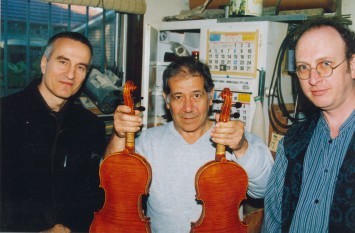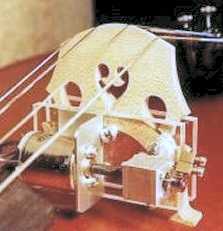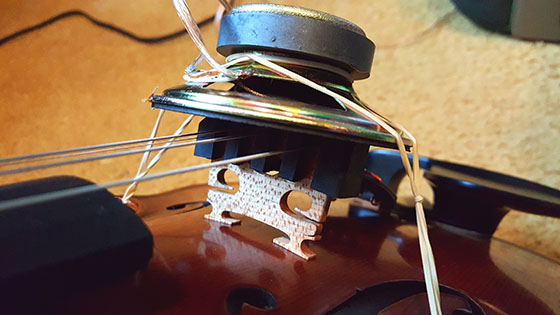By Andy Fein, Luthier at Fein Violins
and Ivana Truong
and Ivana Truong
In one of the few studies about the subject, a set of very similar violins made by Harry Vatiliotis in Australia were used to study the development of tone over time. One was used as a primary performance instrument and one was kept by the Powerhouse Museum in Sydney. After 3 years of vastly different conditions and playing times, they were reunited. After a blindfolded "expert board" and Romano Crivici, the violinist who used one of the violins, played and evaluated both instruments, they found no statistically significant difference in ratings. Although many variables are uncontrolled and the experiment hasn't been repeated, the study would suggest that simply the aging of materials and the musician getting used to the instrument impacts the tone, not the "breaking in" of a violin.
 |
| Harry Vatiliotis and the newly made "Powerhouse Twins" |
It's important to realize that every violin, viola, and cello, even the great Stradivaris, Amatis, and Guarneris, were once brand new instruments. That means they had fairly new wood and fresh varnish. They definitely sounded different when they were new! They probably went through some break in period.
Even old instruments that have gone through extensive restorations will have lots of new wood on the inside and probably large patches of fresh varnish on the outside. So, new or old, there will probably be a break in period and adjustment period for the player.
I'm quite convinced that a large component of the "playing in" that musicians conceive of is actually the player becoming more intimately knowledgeable about their instrument, knowing the nuances, and learning how to bring out the best in the instrument. I think the best way you can break in your violin is by playing it. A lot! But no one can play
24 hours each day. Given all that, here's some things that people are trying and some recommendations we have.
Without any definitive proof, most of the debate around the subject occurs on internet forums, which quickly devolve into anecdotes, speculation, and questionable claims from strangers on the internet. When researching, I found several of these forums dedicated to a 'de-damping service' offered by Siminoff Banjo and Mandolin Parts. On their website, they state that the $125 service consists of "24 hours of continuous mechanical strumming, 48 hours of mechanical agitation, 8 hours of continuous external excitation of the backboard, 8 hours [of] continuous excitation of the air chamber, and 8 hours [of] continuous external excitation of the soundboard" for mandolins. Whether or not it's effective according to the forums, the jury still seems out. It does have lower cost than the option below (ToneRite at $200) and it probably works to some extent. But I know if a violinist heard the words "mechanical agitation" and "external excitation" applied to their violin, combined with this video of a homemade de-damping machine below, they might pass out. The service does seem likely to damage or shift the bridge of a violin and the fact that the process looks somewhat crude would unsettle many musicians handing over an expensive new instrument. It undeniably looks a bit like violin torture. While this might work just fine for banjos and mandolins, let me give my professional advice as a violin maker and restorer with over forty years of experience in the field- DON'T DO THIS TO YOUR VIOLIN, VIOLA, OR CELLO. JUST DON'T!
if you're not quite ready to ship off your new violin to boot camp, maybe you would like a a ToneRite. The ToneRite is a $199 small black box that attaches to an instrument while emitting "subsonic" waves that are supposed to mimic heavy playing.
Subsonic? Do you know what that means? It means "slower than the speed of sound". So, not sound. Something else. What goes slower than the speed of sound? Lots of stuff- planes, cars, trains, a person walking, etc. The problem here is that your string instrument is producing sound. That is, your musical instrument is producing vibrations that travel at the speed of sound. Because they are sound. So, will vibrating your instrument with non-sound vibrations help it sound better? Probably not.
On the other hand, the ToneRite has apparently sold thousands of units and in 2010 garnered enough attention to have a NY Times article written about it. It does look more polished and since it's a product not a service, you could use it on any number of your instruments. On Amazon, reviews seem mostly positive, averaging at 4 stars. If you're willing to spend the cash, maybe this is the option for you. In terms of personal experience, I've tried the ToneRite on a few different instruments over the years. My conclusion- meh. And if you decide to use one- Be very careful not to move or stress the bridge.
Sources:
http://newt.phys.unsw.edu.au/jw/reprints/IntaViolin.pdf
Even old instruments that have gone through extensive restorations will have lots of new wood on the inside and probably large patches of fresh varnish on the outside. So, new or old, there will probably be a break in period and adjustment period for the player.
Several cellos with repairs that would alter their sound
 |
 |
I'm quite convinced that a large component of the "playing in" that musicians conceive of is actually the player becoming more intimately knowledgeable about their instrument, knowing the nuances, and learning how to bring out the best in the instrument. I think the best way you can break in your violin is by playing it. A lot! But no one can play
24 hours each day. Given all that, here's some things that people are trying and some recommendations we have.
Without any definitive proof, most of the debate around the subject occurs on internet forums, which quickly devolve into anecdotes, speculation, and questionable claims from strangers on the internet. When researching, I found several of these forums dedicated to a 'de-damping service' offered by Siminoff Banjo and Mandolin Parts. On their website, they state that the $125 service consists of "24 hours of continuous mechanical strumming, 48 hours of mechanical agitation, 8 hours of continuous external excitation of the backboard, 8 hours [of] continuous excitation of the air chamber, and 8 hours [of] continuous external excitation of the soundboard" for mandolins. Whether or not it's effective according to the forums, the jury still seems out. It does have lower cost than the option below (ToneRite at $200) and it probably works to some extent. But I know if a violinist heard the words "mechanical agitation" and "external excitation" applied to their violin, combined with this video of a homemade de-damping machine below, they might pass out. The service does seem likely to damage or shift the bridge of a violin and the fact that the process looks somewhat crude would unsettle many musicians handing over an expensive new instrument. It undeniably looks a bit like violin torture. While this might work just fine for banjos and mandolins, let me give my professional advice as a violin maker and restorer with over forty years of experience in the field- DON'T DO THIS TO YOUR VIOLIN, VIOLA, OR CELLO. JUST DON'T!
if you're not quite ready to ship off your new violin to boot camp, maybe you would like a a ToneRite. The ToneRite is a $199 small black box that attaches to an instrument while emitting "subsonic" waves that are supposed to mimic heavy playing.
Subsonic? Do you know what that means? It means "slower than the speed of sound". So, not sound. Something else. What goes slower than the speed of sound? Lots of stuff- planes, cars, trains, a person walking, etc. The problem here is that your string instrument is producing sound. That is, your musical instrument is producing vibrations that travel at the speed of sound. Because they are sound. So, will vibrating your instrument with non-sound vibrations help it sound better? Probably not.
On the other hand, the ToneRite has apparently sold thousands of units and in 2010 garnered enough attention to have a NY Times article written about it. It does look more polished and since it's a product not a service, you could use it on any number of your instruments. On Amazon, reviews seem mostly positive, averaging at 4 stars. If you're willing to spend the cash, maybe this is the option for you. In terms of personal experience, I've tried the ToneRite on a few different instruments over the years. My conclusion- meh. And if you decide to use one- Be very careful not to move or stress the bridge.
 |
| ToneRite patented device that functions by strumming the strings with a "plurality of flanges extending between the strings" |
At our shop, the process is much more low tech. Upstairs, we use headphones plugged into a radio on a classical radio station, to "break in" one violin at a time. In the picture at the top of this blog, you'll notice the violin with the headphones is not set up. That is, it doesn't have any strings or a bridge. That's a great time for me, a skilled luthier, to do this headphone method. You, dear reader, probably don't have the skills to set up a violin if the soundpost falls or the bridge moves. So, I suggest an even simpler method-
Turn your instrument on its side on a large table or workbench, large enough that it won't slip off and crash to the floor. Gently put the bridge of the instrument right up against the radio speaker. Tune the radio to a classical music station and crank up the radio as loud as you can stand. then leave it there for a few hours or overnight. Do that a few times and see if you can hear any difference. Using a radio certainly doesn't cost much and it doesn't hurt to try.
At night, we turn up the ground floor radios to approximately 70 Decibels. (For context, orchestras can reach about 98 Decibels and any sound above 90 Decibels can be damaging to your ears.) If you're in the St. Paul area, stroll by the shop sometime after 6 PM and before 10 AM. We have two Sangean table top radios that we crank up to the loudest volume and let every instrument in the shop vibrate to Classical MPR all night long. You'll hear the music playing inside the shop from the walkway on the outside.
If you're trying to break in a new violin, maybe give these methods a shot, but most importantly, practice!
In any of these methods, it's important to point out some safety tips-
1) Loud sounds are powerful. If you hear anything rattling or smell something smoking or burning- STOP!
2) Make sure your instrument is in a position where it is safe. Large vibrations can move the instrument off of a table if it is not secured in some manner or has a foot or two to move before it slips off the table.
3) If the sound or vibrations are loud enough to hurt your ears- STOP! You won't be much of a musician with damaged hearing.
4) Make sure the bridge doesn't move out of position. Moving the bridge is going to negatively effect the sound far more than any positive breaking in method.
5) If you leave your instrument outside of the case, make sure the temperature and humidity in the room are moderate. Be especially careful of low humidity in the winter.
In conclusion, what's the best method to "play in" or "break in" your new violin, viola, or cello? Play it a lot! It's that simple.
And one caveat- A good instrument should sound good right away. NEVER buy an instrument based on what you HOPE it might sound like after you've played it for a few months or years. At the shop, we offer both vintage and brand new instruments, which you can take a look at on our website- www.fineviolins.com.
Turn your instrument on its side on a large table or workbench, large enough that it won't slip off and crash to the floor. Gently put the bridge of the instrument right up against the radio speaker. Tune the radio to a classical music station and crank up the radio as loud as you can stand. then leave it there for a few hours or overnight. Do that a few times and see if you can hear any difference. Using a radio certainly doesn't cost much and it doesn't hurt to try.
 |
| One of our violins placed in front of a loud radio after closing |
 |
| A cello dedampener based on the work of Dr. Gottfried Lehmann. I couldn't find any similar devices on the market. image by Henry Strobel |
In any of these methods, it's important to point out some safety tips-
1) Loud sounds are powerful. If you hear anything rattling or smell something smoking or burning- STOP!
2) Make sure your instrument is in a position where it is safe. Large vibrations can move the instrument off of a table if it is not secured in some manner or has a foot or two to move before it slips off the table.
3) If the sound or vibrations are loud enough to hurt your ears- STOP! You won't be much of a musician with damaged hearing.
4) Make sure the bridge doesn't move out of position. Moving the bridge is going to negatively effect the sound far more than any positive breaking in method.
5) If you leave your instrument outside of the case, make sure the temperature and humidity in the room are moderate. Be especially careful of low humidity in the winter.
In conclusion, what's the best method to "play in" or "break in" your new violin, viola, or cello? Play it a lot! It's that simple.
And one caveat- A good instrument should sound good right away. NEVER buy an instrument based on what you HOPE it might sound like after you've played it for a few months or years. At the shop, we offer both vintage and brand new instruments, which you can take a look at on our website- www.fineviolins.com.
Sources:
http://newt.phys.unsw.edu.au/jw/reprints/IntaViolin.pdf






Thank you for writing and posting this article, Andy.
ReplyDeleteActually in the aforementioned experiment, the violin which was played extensively also was affected by changing temperatures and humidity whereas the one in the museum was played occasionally but also enjoyed the privilege of constant humidity and temperature. Secondly I do agree new instruments should sound good but in almost all cases new instruments sound just a little harsh or bright when the wood has just been recently glued, varnished and set up, it does take some time for the stresses from the peg box all the way to the end pin to stabilise, which is also the reason why most new violins are tuned everyday and isn't usually sold off and played in the concert hall on day 1 of its final setup.
ReplyDeleteI almost stopped you as you were walking from your car to the house the other day to discuss this very topic, specifically to get your opinion as to the validity of the theory. I'm currently in the process of deciding whether to purchase a Dr. Herringbone Tone Traveler for my Collings dreadnought acoustic guitar. I decided not to bother you -- and my two mini schnauzers wouldn't have allowed us to talk anyway. But lo and behold, who do I discovery as having written a blog article on the very topic? Can't make it up. Later, Neighbor! -- Matt Torgerson (red house on Saint Clair, two down and across the street from the end of your street)
ReplyDeleteThanks! Always good to hear from a neighbor. My expertise is in violin family instrument (violin, violas, and cellos), but I'd guess the same general principles hold true.
ReplyDelete